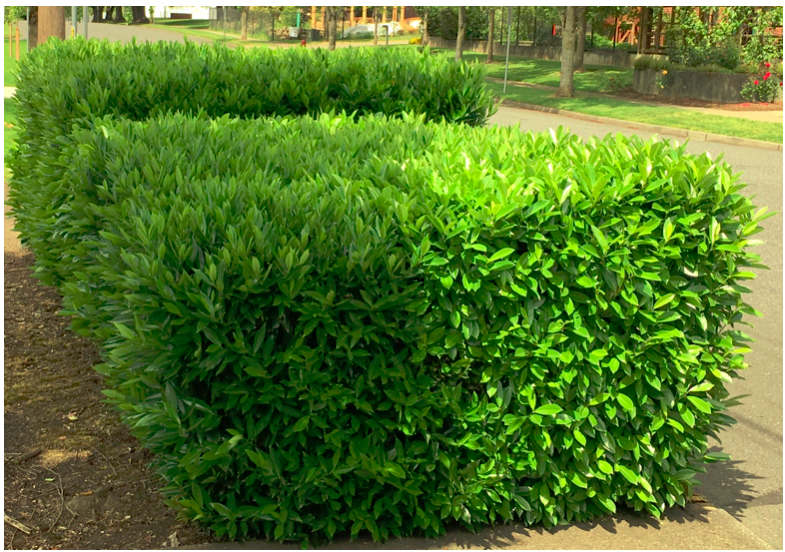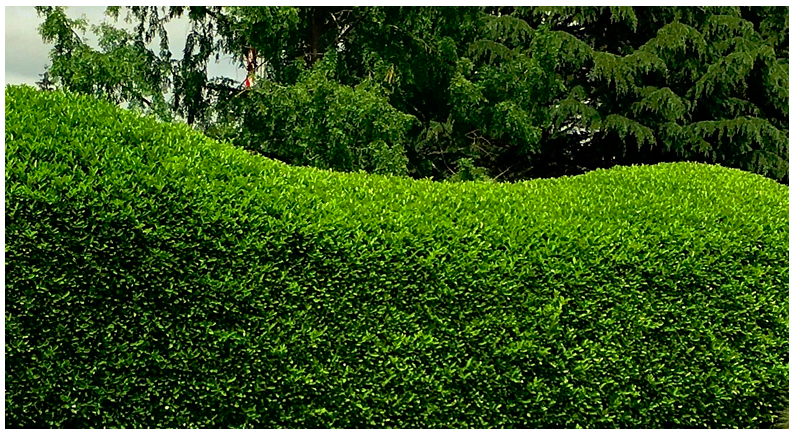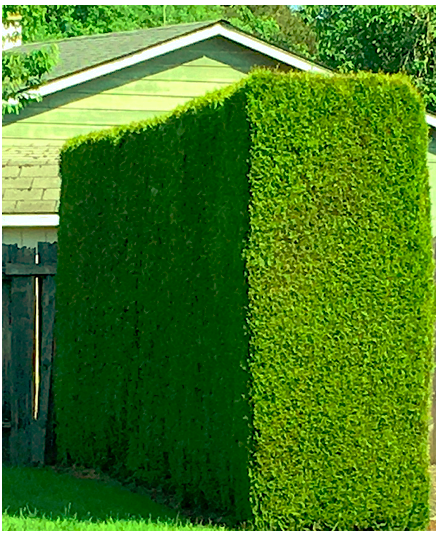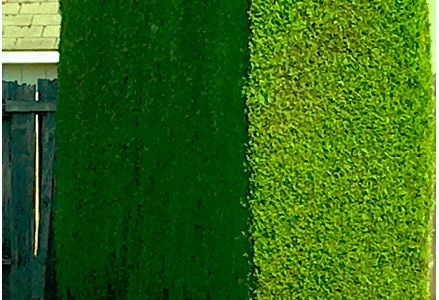A Little Green Corner of the Commons
by Bubby LiV
The noble hedge: one of the most expressive and dynamic features in the man-made landscape. A three-dimensional living wall, a garden that defies gravity. Hedges and their beefier kin, hedgerows, have been around for at least 4,000 years. In Great Britain, where their conservation is taken quite seriously, hedgerows are literally loved to the moon, with over 240,000 linear miles of managed hedgerows.
An early memory of mine goes back to preschool years; looking from my bed to see a nighttime silhouette of the hedge outside my window. Viewed through young eyes, they were toy soldiers grown magically life-sized to watch over and protect a sleeping child.
As an adult, my fondness for the mighty hedge is no less fervent for being grounded in waking reality. Who doesn’t love a part of the garden capable of answering answer so many questions:
How can different areas of my property be separated for different functions?
What, other than a fence, can be used to delineate my property line?

What will take the unsightly view of my neighbor’s yard out of my view-shed?
How I cut down traffic noise, air pollution or damage from prevailing winds?

What can I do to keep the neighbor’s alpacas out of my yard?
How can I create a small play-yard which will contain a child while allowing visibility from the outside?
How can I increase biodiversity, inviting desirable wildlife into my space by providing pollen, food and shelter?

What is an innovative way to allow the winter sun to shine through and in summer -in that very same spot- to provide a shady nook where one can enjoy a cold one whilst browsing seed catalogues?
Is there a way to grow food vertically?
In a classic scene from Monty Python and the Holy Grail, King Arthur is sent by the Knights-who-say-Ni to find “a shrubbery”. To his great good fortune Roger the Shrubber soon appears.
In real life the creation of a hedge is also a personal quest of sorts in which the home gardener relies upon her/his own planning and research to make sure things come out right. There are so many great resources for planning shrubbery that your first challenge might be that of navigating back from the webs before planting season has passed you by.
Before diving into the mind-blowing range of available plant choices, it is prudent to do a needs assessment. After all, to invite a hedge into one’s space is to embark upon a partnership, and impulse buys seldom turn out well for any relationship. For a quick list of more mundane considerations, see Making Love Last.

Not to put too fine a point on it, but the term “to plant” has already contained within itself the best possible advice: plan.
So, not to be a nag, but do your homework. You won’t be sorry.
And then comes the fun part: choosing your plants.
If you are a traditionalist with a good eye, a mean set of shears and a ton of energy wanting to create leaping dolphins or icosahedrons from your greenery, the time honored topiary choices will serve well. Boxwood (Buxus sp.), Privet (Ligustrum sp.), Laurel (Prunus sp.), Yew (Taxus sp.), and Holly (Ilex sp.) are favorites.
If your space has a Mediterranean feel, consider Euonymus (Euonymus japonicus), Photinia (Photinia sp.), Holly (Ilex sp.), Arborvitae (Thuja sp.) or California Wild Lilac (Ceanothus sp.).
A fan of cottage style? Your best match might be one of the following: Hawthorn (Crataegus sp.), Holly (Ilex sp.), California Wild Lilac (Ceanothus sp.), Arrowwood (Viburnum sp.), Escallonia (Escallonia sp.), Lilac (Syringa sp.) or Barberry (Berberis sp.).
After a tranquil zen feel? Clumping bamboo (Fargesia sp.), Oregon Grape (Mahonia aquifolia), False holly (Osmanthus heterophyllus ‘Goshiki’), Rhododendron (Rhododendron sp.) and Heavenly Bamboo (Nandina domestica) are all worthwhile options.
Among hedge plants Arborvitae is one of the most recognizable. The abundance of species and cultivars will simplify finding your perfect match. For traditional hedges the following are good choices: American Arborvitae (Thuja occidentalis ‘Nigra’), Green Giant Arborvitae (Thuja standishii x plicata ‘Green Giant’), American Arborvitae (Thuja occidentalis) and Emerald Arborvitae (Thuja occidentalis ‘Emerald’). Easy to find in garden centers and nurseries, arborvitae does have a few limitations:
1.It is difficult to look at a neat row of arborvitae and not think of Tuscany, so I have always felt that this plant somewhat limits the feel of surrounding garden to a Mediterranean motif. It simply does not, for me, vibe ‘temperate zone’, with the possible exception of, say, a cemetery. It does not seem to mesh well with styles like English cottage or hardwood forest.
2.As a row of arborvitae fills in over time, the layer-upon-layer of waxy scale leaves shed rainfall, developing dry pockets with shade-killed interior branches that are as dry and dusty as a pharoah’s tomb. One solution is to open up the architecture, streamlining lower branches by trimming away secondary growth. Careful removal of the mass of prim green skirt will open to view the rough reddish trunk and limbs, as well as providing easier access for irrigation and mulching. If desired, underplanting can be added for a pleasing effect.

3.In overcrowded conditions, a previously thriving arborvitae hedge can begin to exhibit symptoms of drought stress followed by an abrupt and irreversible crash; from showing yellow-brown patches to sudden death only months later. The cry for help might go unheard unless a gardener is, so to speak, riding the fence-line. It’s a disturbing image, the row of formerly stately arborvitae trees punctuated by standing brown corpses of their comrades.
4.If pruning is neglected for too long, subsequent efforts to rein in the exuberant foliage may leave behind a horribly hacked-up look.

Planting a hedge has elements of fun and whimsy, but is also the beginning of a long-term relationship. As with any mutually beneficial association between living beings -at least one of whom is human- understandings and agreements should be in place from the outset. Impulse plant buys are rarely a good idea and elopement is not an option.
Now, get out there and fall in love!
BL

